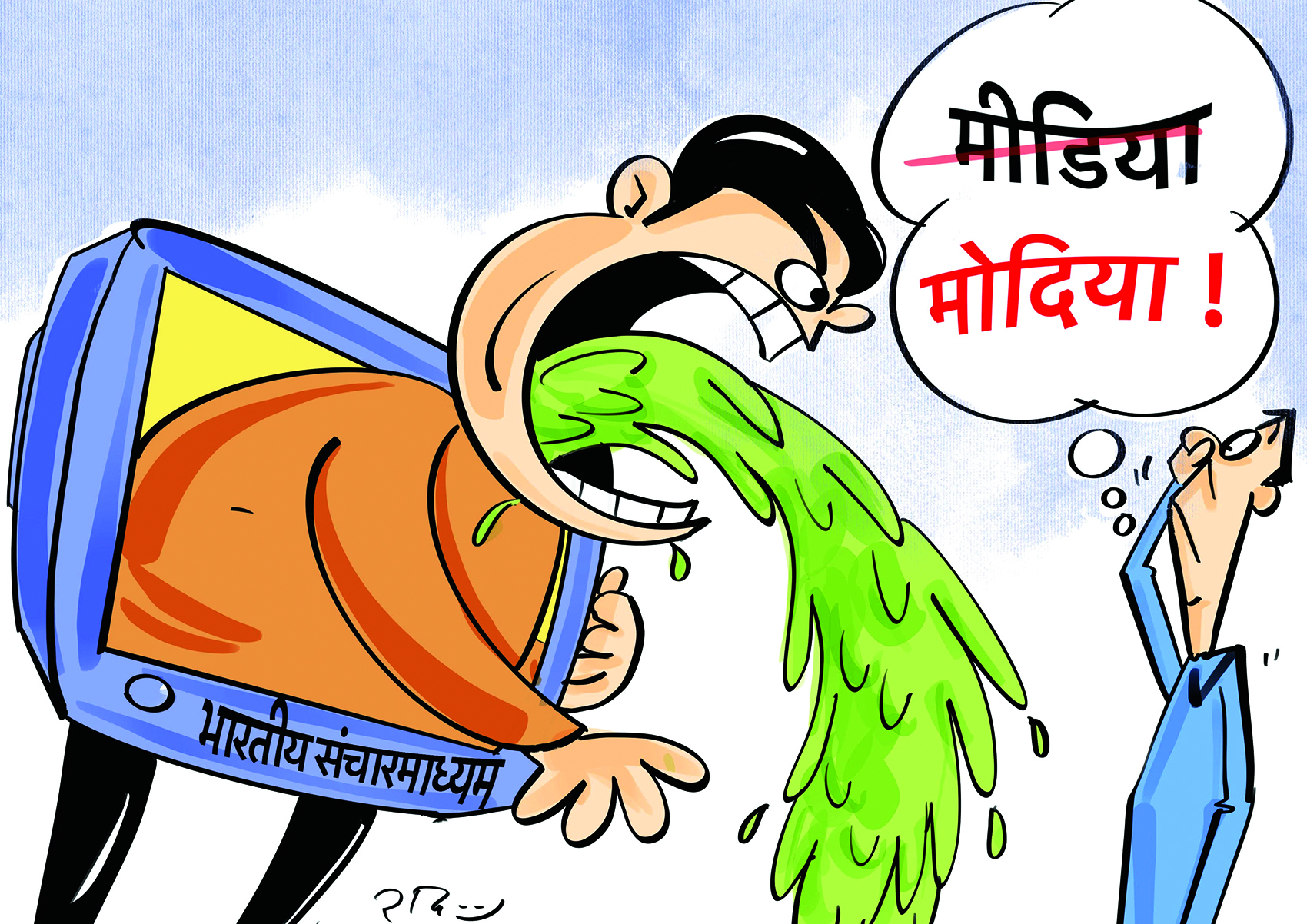नयाँदिल्ली — नेपाल र प्रधानमन्त्री केपी शर्मा ओलीविरुद्ध भारतीय मिडियाबाट दुष्प्रचार भइरहेको विषयमा नेपालले भारतसमक्ष असन्तुष्टि प्रकट गरेको छ । दिल्लीस्थित नेपाली दूतावासले बिहीबार यस विषयमा भारतको विदेश मन्त्रालयलाई मौखिक रूपमा ध्यानाकर्षण गराएको छ । स्रोतका अनुसार भारतका लागि नेपालका राजदूत नीलाम्बर आचार्यले भारतीय मिडियामा आएका सामग्रीका सम्बन्धमा भारतीय विदेश मन्त्रालयका उच्च अधिकारीहरूसँग कुरा गरेका थिए ।
उनले भारतीय विदेश मन्त्रालयका उच्च अधिकारीलाई भारतीय मिडियामा आएका समाचार सामग्रीले नेपाल र भारतबीचको सम्बन्धमा नै असर पर्ने धारणा राखेका थिए । ‘सबैमा नभएर केही भारतीय मिडियामा आएका सामग्री आपत्तिजनक र निन्दनीय छन् नै, ती दुवै देशबीचको सम्बन्ध बिगार्न उद्यत् छन् । त्यसैले यस विषयमा भारतीय पक्षलाई ध्यानाकर्षण गराइसकेको छु,’ राजदूत आचार्यले भने । उनले भारतीय पक्षसमक्ष के कस्ता धारणा राखिएको भन्नेचाहिँ खुलाउन चाहेनन् । नेपाल र भारतबीच एउटा विषय (सीमा) लाई लिएर मतभेद भए पनि जनस्तरको सम्बन्ध बिगार्न खोज्ने किसिमले मिडियामा खबरहरू आउनु आपत्तिजनक भएको उनको भनाइ थियो ।
नेपाल र नेपालको राजनीतिक नेतृत्वविरुद्ध केही दिनयता केही भारतीय मिडियाबाट प्रसारित र प्रकाशित अनर्गल र तथ्यहीन समाचारलाई लिएर नेपालमा तीव्र आक्रोश व्यक्त हुँदै आएको छ । सत्तारूढ नेकपाभित्र चलिरहेको राजनीतिक घर्षणमाथि केही भारतीय मिडियाले पत्रकारिताको आचारसंहिताको खिल्ली उडाउँदै आपत्तिजनक समाचार सम्प्रेषण गर्दै आएका छन् । ती समाचार सामग्री विशेषगरी प्रधानमन्त्री ओलीप्रति लक्षित छन् । नेकपाभित्रको शक्ति संघर्ष र नेपालका लागि चिनियाँ राजदूत होउ यान्छीको राजनीतिक भेटघाटलाई भारतीय मिडियाहरूले बढी नै चासो राख्दै आएका छन् । त्यसक्रममा यी मिडियाले एकतर्फी ढंगले नेपालमा चीनको प्रभाव बढेको र त्यसका पछाडि चिनियाँ राजदूत यान्छीको सक्रियता प्रमुख जिम्मेवार रहेको दाबी गर्दै आएका छन् । चिनियाँ राजदूतको फन्दामा नेपालका प्रधानमन्त्री ओली र अन्य नेता परेको जस्ता तथ्यहीन समाचारलाई पनि जोडतोडका साथ सम्प्रेषण गर्दै आएका छन् ।
बुधबार भारतीय हिन्दी च्यानल जी ले ओली र चिनियाँ राजदूतलाई जोडेर एउटा विशेष कार्यक्रम नै चलाएको थियो । जसमा ओली चिनियाँ राजदूतको मायामोहमा फसेको आरोप लगाइएको थियो । त्यस समाचार सामग्रीलाई लिएर नेपालमा नागरिकस्तरबाट मात्र नभएर मन्त्री, पूर्वकूटनीतिज्ञ, राजनीतिज्ञबाट समेत चर्को विरोध जनाइएको थियो ।
सोमबार मात्र भारतीय अंग्रेजी दैनिक टाइम्स अफ इन्डियाले नेपालमाथि लेखिएको ‘ओलीको राजनीतिक संकट’ शीर्षकको सम्पादकीयमा प्रधानमन्त्री ओलीलाई पार्टीभित्रैबाट संकट रहेको देखाउन ओली मुहार भएको एउटा हिमाली याकको शरीरभरि बाणैबाण प्रहार भएको देखाइएको थियो । उक्त कार्टुनलाई लिएर पनि नेपालमा चर्को विरोध गरिएको थियो ।
सत्तारूढ नेकपाका प्रवक्ता नारायणकाजी श्रेष्ठ, पर्यटनमन्त्री योगेश भट्टराईलगायतले त्यसप्रति आक्रोश व्यक्त गरेका थिए । ‘भारतीय सञ्चारमाध्यमले हाम्रो सरकार र प्रधानमन्त्रीका बारेमा गरेको अनर्गल प्रचारले सीमा नाघ्यो । हद भयो । बकवास बन्द गर…’ नेकपाका प्रवक्ता श्रेष्ठले ट्वीटमार्फत भनेका थिए ।
यस किसिमका समाचार सामग्रीबारे दिल्लीस्थित नेपाली दूतावासले भारत सरकारसमक्ष औपचारिक रूपमा विरोध जनाउनुपर्ने मागसमेत उठेको थियो । दूतावासले कुनै प्रतिक्रिया नजनाएको भन्दै नेपालका पूर्वकूटनीतिज्ञदेखि जनस्तरबाट समेत आलोचना सुरु भएको थियो । पूर्वपरराष्ट्र सचिव मधुरमण आचार्यले त भारतीय मिडियामा आएका समाचारको खण्डन गर्नुपर्ने बताएका थिए । ‘जुनस्तरमा नेपालको प्रधानमन्त्रीलाई जोडेर केही च्यानल प्रस्तुत भइरहेका छन् । त्यसको जवाफ दिएर साध्य नहुने भए पनि दिल्लीस्थित दूतावासबाट विदेश मन्त्रालयमार्फत विरोध र त्यहाँको मिडियामा खण्डन पठाउन आवश्यक छ,’ उनले ट्वीटमा लेखेका थिए ।
पूर्वमन्त्री जेपी गुप्ताले दूतावासको भूमिकामाथि प्रश्न गरेका थिए । ‘भारतीय मिडिया, खासगरी केही टीभीले दिनहुँ नेपालका बारेमा प्रसारण गरिरहेको गलत सामग्रीबारे भारतका लागि नेपाली राजदूतको के कुनै भूमिका हुन सक्दैन ?’ उनले ट्वीटमार्फत प्रश्न गरेका थिए ।
त्यसो त नेपाललक्षित दुष्प्रचारको शृंखला २६ वैशाखमा भारतले मानसरोवर जाने सडकको ट्रयाक नेपाली भूमिमा बनाएर उद्घाटन गरेकामा नेपालले विरोध गरेपछि सुरु भएको हो । त्यसयता नै भारतीय संस्थापन नजिक मानिएका मिडियाले नेपाल र प्रम ओलीप्रति एकपक्षीय ढंगले निरन्तर प्रहार गर्दै आएका छन् । यसबीचमा नेपालको सार्वभौमिकतामा चोट पुर्याउने, दुई देशबीचको सम्बन्धमा असर पार्ने समाचार सामग्री सँगै आपत्तिजनक कार्टुनसमेत प्रकाशित भएका छन् । यसमा भारतको सत्ता र सत्तारूढ दल भारतीय जनता पार्टीनिकट मानिने अनलाइन, छापा माध्यम र टीभी च्यानल अगाडि रहेका छन् । सामान्यतया: यस्तो घटनामा अन्तर्राष्ट्रिय सम्बन्धका पारस्परिक सम्मानलगायतका मुख्य आधारलाई उद्धृत गर्दै सम्बन्धित देशलाई मौखिक र लिखित रूपमा ध्यानाकर्षण गराउने प्रचलन छ । तर नेपालले अहिलेसम्म कुनै पनि प्रतिक्रिया जनाएको थिएन । सामाजिक सञ्जाल प्रयोगकर्ताहरूले राजदूत आचार्यलाई नै उल्लेख गरेर आक्रोशसमेत पोखेका थिए ।
भारतका लागि नेपालका पूर्वराजदूत भेखबहादुर थापाले भारतीय मिडियाले विगतमा पनि यस किसिमको दुष्प्रचार गर्ने गरेको स्मरण गर्दै यसलाई रोक्न दूतावासको भूमिका अर्थपूर्ण हुने बताए । उनले भारतीय मिडियालाई प्रत्यक्ष रूपमा हस्तक्षेप गर्न नमिल्ने भए पनि सम्पर्क बढाएर केही मत्थर पार्न सकिने बताए । ‘दूतावासले मिडियाका सम्पादकहरूसँग नियमित सम्पर्क राखेर आफ्नो धारणा राख्नुपर्छ । जसले एकतर्फी रूपमा प्रसारण हुने सामग्रीलाई पूर्णरूपमा रोक्न नसकिए पनि धेरै कम भने गर्न सकिन्छ,’ उनले भने ।
त्यसो त केही वर्षयता केही भारतीय मिडियाको भूमिकामाथि स्वयं भारतमै पनि प्रश्न उठ्दै आएको छ । विशेषगरी सत्तानिकट सञ्चार गृहमाथि पत्रकारिताको विश्वव्यापी मान्यता र मर्यादासमेत ख्याल नगरेको आरोप आलोचकहरूले लगाउने गरेका छन् । आलोचकहरूले भारतीय सत्तानिकट मिडियालाई ‘गोदी मिडिया’ भनेर व्यंग्यसमेत गर्ने गरेका छन् । वरिष्ठ पत्रकार रविश कुमार त त्यस्ता गलत समाचार सम्प्रेषण गर्ने टीभी मिडिया र पत्रिकालाई नहेर्नु र नपढ्नुमा सबै भलो हुने बताउँछन् । भारतीय मिडियाले नेपालका सम्बन्धमा पछिल्लो समय प्रसारण गरिरहेका समाचार सामग्रीबारे आफू जानकार नभए पनि त्यस्तो सामग्री प्रकाशन र प्रसारण हुनु नौलो नभएको बताए । ‘भारतीय मिडियाको सन्दर्भमा यो नौलो कुरा होइन । त्यसैले मैले धेरै अघि नै त्यस्ता टीभी हेर्न र पत्रिका पढ्न छाडिसकेँ । गलत किसिमका समाचार नपढ्नु र नहेर्नु नै सबैका लागि हितकर छ,’ उनले कान्तिपुरसित भने ।
प्रकाशित : असार २६, २०७७ १०:३३
